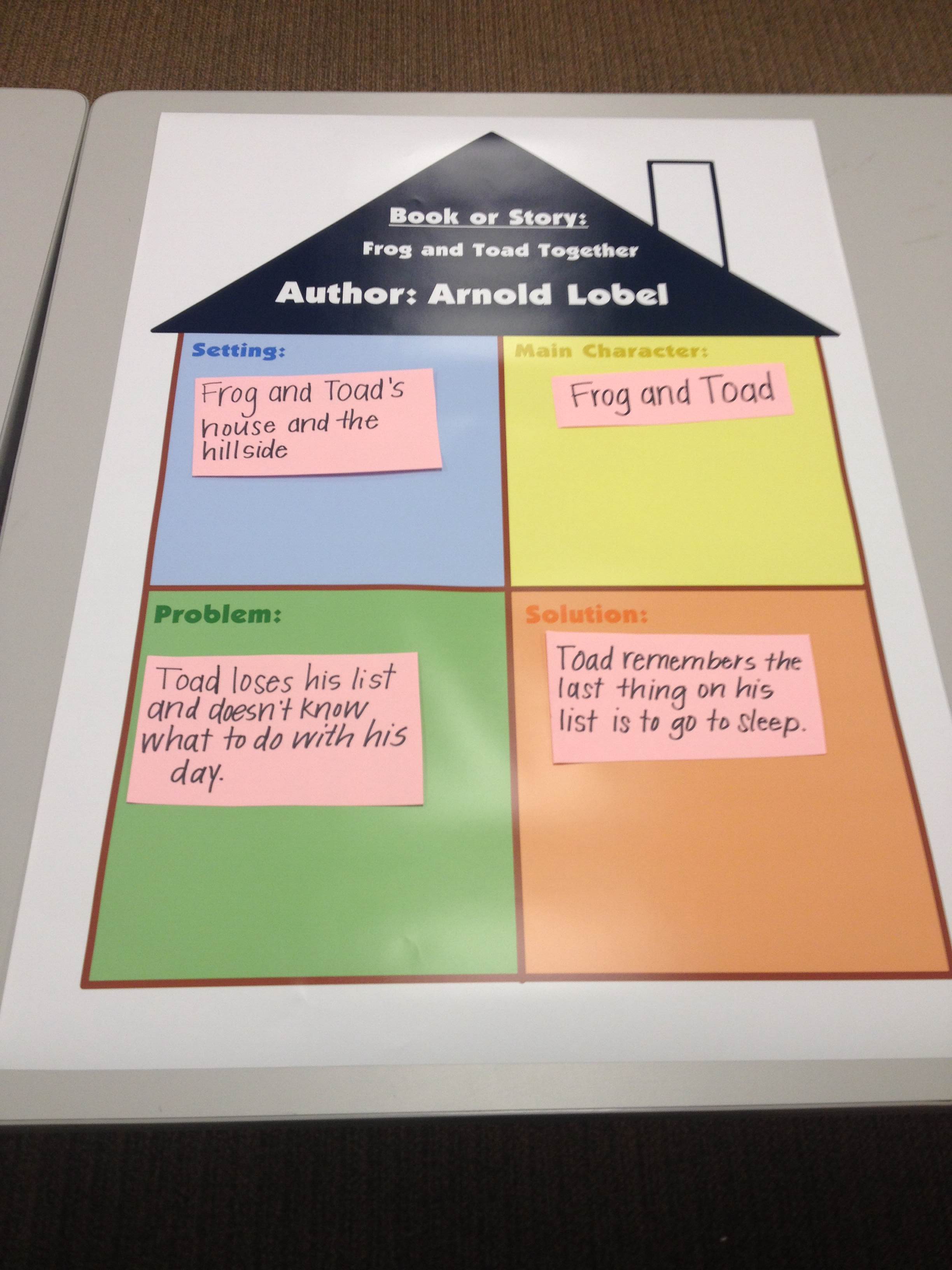Use a graphic organizer to help students identify and describe the characters, settings, and major events in a story, using key details. (RL.1.3)

Print Story House graphic organizer (ORG104) for the Perfecta™ 2400 Full Color Poster Design System. Cut out several rectangles using the Cutout Maker Rectangle (MTH317) or use word/sentence strips.
Display the Story House graphic organizer poster on a magnetic whiteboard or easel. Introduce each section of the graphic organizer and make sure all students understand the terms: setting, characters, problem and solution. Prepare students for the read aloud by having them think about each of these elements of the story as they listen to the book.
Read aloud A List from the book, Frog and Toad Together, by Arnold Lobel, with the whole class. (For literature ideas that align with the Common Core Standards for Language Arts, check out the book list compiled by Scholastic:
http://commoncore.scholastic.com/teachers/books/literature
Divide students into four small groups and assign each group an element of the story: character(s), setting, problem and solution. Give each group a marker and 1-2 rectangle cutouts or word/sentence strips to record the characters, setting, problem or solution.
Gather students together again as a whole group and have one student from each small group bring his/her word strip up, read it out loud to the group, then add it to the poster using magnets or tape. After each group adds their story element to the graphic organizer, ask the other students if they agree or disagree by giving a thumbs up or thumbs down. Discuss and make any changes necessary.
Next, assign the small groups each a different chapter from Frog and Toad Together and have them identify the four elements of the story, then record the title, author, setting, main character(s), problem and solution on strips. Have students give short presentations, where they read their group’s chapter out loud to the rest of the class, then explain the elements of the story using the Story House graphic organizer as a visual.







![[Lesson Plan Activity] ELL Bingo](https://content.cdntwrk.com/mediaproxy?url=https%3A%2F%2Finfo.variquest.com%2Fhubfs%2F3D%2FLesson_Plan_Pics%2Fell%2520bingo%2520header.png&size=1&version=1753195128&sig=ebc051ac021c1960f75e8f80a97d9355&default=)
![[Lesson Plan] First Day of School Feelings](https://content.cdntwrk.com/mediaproxy?url=https%3A%2F%2Finfo.variquest.com%2Fhubfs%2Fimages%2FProducts%2FCutout_Maker%2Fthe%2520start%2520of%2520a%2520new%2520school%2520year%2520cutout%2520maker.jpg&size=1&version=1752780346&sig=847b11606c169458fea71bb69e2360e0&default=)
![[Lesson Plan Activity] Kindness Calendar](https://content.cdntwrk.com/mediaproxy?url=https%3A%2F%2Finfo.variquest.com%2Fhubfs%2F3D%2FLesson_Plan_Pics%2Fkindness%2520calendar%2520header.png&size=1&version=1752703157&sig=3fa07390d2b175137c148d7763d6a980&default=)





![[Lesson Plan] Celebrate the Chinese New Year 2025!](https://content.cdntwrk.com/mediaproxy?url=https%3A%2F%2Finfo.variquest.com%2Fhubfs%2FCarman%2FCNY%25201-2018%2F%25E6%2581%25AD%25E5%2596%259C%25E7%2599%25BC%25E8%25B2%25A1.png&size=1&version=1737070708&sig=d89d716a42e2737ee7122119d2052225&default=)


![[Lesson Plan] Election Activities for Grades 2-6](https://content.cdntwrk.com/mediaproxy?url=https%3A%2F%2Finfo.variquest.com%2Fhubfs%2FLesson_Plan_PDFs%2Felections%2520lesson%2520plan%2520header%2520blog.png&size=1&version=1730049507&sig=c8f9bdb2545ac4d7408ee3c224f15b3d&default=)





![[Lesson Plan] Arbor Day Activities for Grades 4-6](https://content.cdntwrk.com/mediaproxy?url=https%3A%2F%2Finfo.variquest.com%2Fhubfs%2FLesson_Plan_PDFs%2Farbor%2520day%2520activities%2520blog%2520header.png%23keepProtocol&size=1&version=1713281322&sig=fa93c6558caab80b84ee1b7a3f74e75c&default=)